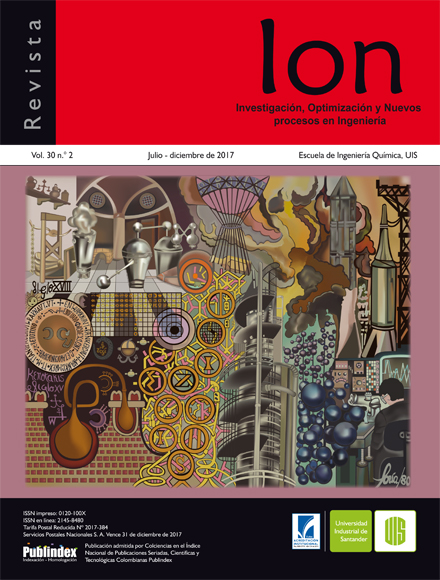Kinetic study and removal of contaminants in the leachate treatment using subsurface wetlands at pilot scale
Published 2018-05-06
Keywords
- kinetic,
- leachate,
- metals,
- removal,
- wetland
How to Cite
Copyright (c) 2018 Revista ion

This work is licensed under a Creative Commons Attribution 4.0 International License.
Abstract
The treatment of stabilized leachate from the Curva de Rodas landfill site in Medellin, Colombia, was evaluated using horizontal subsurface flow constructed wetlands (HSSF) planted with Phragmites australis at pilot scale. Assays were performed in two stages: the first with hydraulic loads (q) of 0.015 and 0.030md-1 and the second with loads of 0.060 and 0.091md-1. A wetland without plants was used as a control. Removals of 71.9, 91.2 and 75.1% for COD, BOD5 and NH4 +-N, respectively, were obtained. Kinetic constants were determined for each q or hydraulic time retention for COD, BOD5 and NH4 +-N with ranges into 0.103 and 0.413d-1, 0.065 and 1.208d-1, and 0.113 and 0.418d-1; respectively, in accordance with a first order under piston flow. And by linear regressions had a magnitude of 0.246 d-1 for the removal of COD (R2 = 0.955), 0.299d-1 for NH4 +-N (R2 = 0.922) and 0.199d-1 for BOD5 (R2 = 0.140). The elimination of mercury, lead, arsenic and zinc was also evaluated, achieving removals of: 37.8-92.9% Hg, 29.9- 44.9%Pb, 7.9-77.6%As and 22.9-64.3%Zn, depending on the hydraulic load applied. The accumulation of these metals in the leaves, stems and roots (rhizomes) of Phragmites australis was found as: 0.575-3.201mgHgkg-1, 0.649-4.718mgPbkg-1, 3.548-39.376mgZnkg-1, and 19.4mgAskg-1.
Downloads
References
[2] Kadlec RH. Comparison of free water and horizontal subsurface treatment wetlands. Ecol. Eng. 2009;35:159-74.
[3] Vymazal J. Review. The use constructed wetlands with horizontal sub-surface flow for various types of wastewater. Ecol. Eng. 2009;35:1-17.
[4] Brix H. Use of constructed wetlands in water pollution control: Historical development, present status, and future perspectives. Water Sci. Technol. 1994;30:209-33.
[5] Kadlec R, Wallace S. Treatment Wetlands. Florida: Taylor & Francis Group; 2009.
[6] Vymazal J, Kröpfelová L, Švehla J, Chrastný V, Štíchová J. Trace elements in Phragmites australis growing in constructed wetlands for treatment of municipal wastewater. Ecol. Eng. 2009;35:303-09.
[7] Rousseau DPL, Vanrolleghem PA, Pauw ND. Model-based design of horizontal subsurface flow constructed treatment wetlands: a review. Water Res. 2004;38:1484-93.
[8] Kadlec RH, Zmarthieb LA. Wetland treatment of leachate from a closed landfill. Ecol. Eng. 2010;36:946-57.
[9] Tchobanoglous G, Theisen H, Vigil S. Integrated solid waste management: engineering principles and management issues. New York: McGraw Hill; 1993.
[10] McBean EA, Rovers F. Landfill leachate characteristics as inputs for the design of wetlands. In: Mulamoottil G, McBean EA, Rovers F. Constructed Wetlands for the Treatment of Landfill Leachates. Florida: Lewis Publishers; 1999.
[11] Metcalf and Eddy. Wastewater Engineering: Treatment and Reuse. New York: McGraw-Hill; 2003.
[12] Peña MR, Van Ginneken M, Madera C. Subsurface flow constructed wetlands: a natural alternative for domestic wastewater treatment in tropical regions. Eng. Compet. J. 2003;5(1):27-35.
[13] Agudelo RM, Peñuela G, Aguirre NJ, Morató J, Jaramillo ML. Simultaneous removal of chlorpyrifos and dissolved organic carbon using horizontal sub-surface flow pilot wetlands. Ecol. Eng. 2010;36:1401-8.[14] Sanford W, Steenhuis T, Parlange J, Surface J, Peverly J. Hydraulic conductivity of gravel and sand as substrates in rock-reed filters. Ecol. Eng. 1995;4:321-36.
[15] APHA, AWWA, WPCF. Standard Methods for the Examination of Water and Wastewater. Washington, DC; 2012.
[16] Jing RJ, Lin YF. Seasonal effect on ammonia nitrogen removal by constructed wetlands treating polluted river water in southern Taiwan. Environ. Pollut. 2004;127:291-301.
[17] Tao W, Hall KJ, Duff SJB. Performance evaluation and effects of hydraulic retention time and mass loading rate on treatment of woodwaste leachate in surface-flow constructed wetlands. Ecol. Eng. 2006:6;252-65.
[18] Kröpfelová L, Vymazal J, Švehla J, Štíchová J. Removal of trace elements in three horizontal sub-surface flow constructed wetlands in the Czech Republic. Environ. Pollut. 2009:157;1186-94.
[19] Vymazal J, Švehla J, Kröpfelová L, Chrastný V. Trace metals in Phragmites australis and Phalaris arundinacea growing in constructed and natural wetlands. Science of the Total Environment. 2007:380;154-62.

